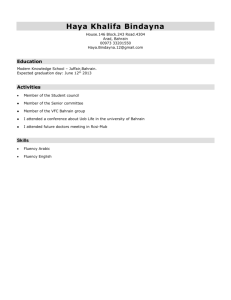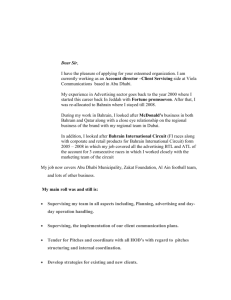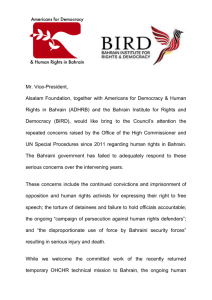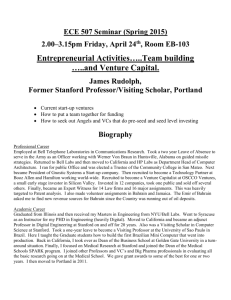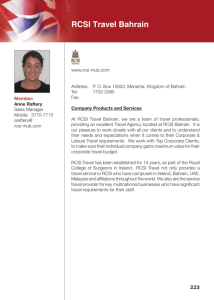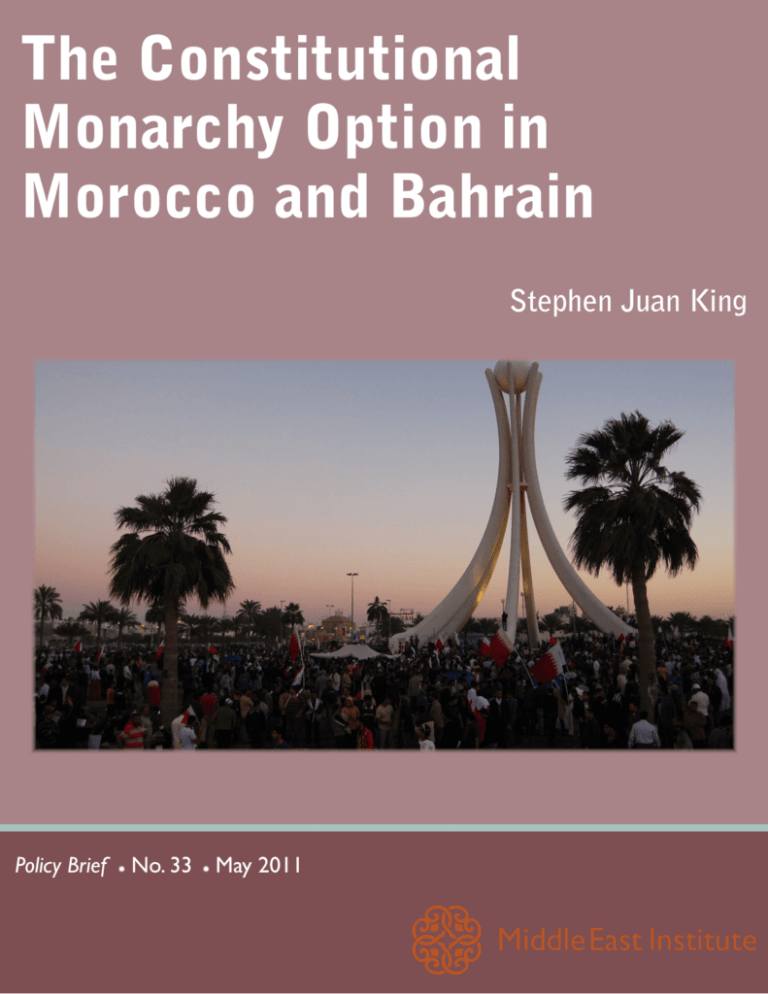
The Constitutional
Monarchy Option in
Morocco and Bahrain
Stephen Juan King
Policy Brief
✹
No. 33
✹
May 2011
Middle East Institute Policy Brief • www.mei.edu
1
© Middle East Institute 2011. All rights reserved. Distribution of this work is permitted for non-commercial use, unmodified, with attribution to the Middle East
Institute.
The Middle East Institute does not take positions on Middle East policy; the
views expressed in this publication are those of the author(s) alone and do not
necessarily reflect the views of the Institute, its employees, or its trustees.
For more publications from the Middle East Institute:
http://mei.edu/Publications/WebPublications.aspx
Cover Photo: Protestors surrounding Pearl Monument in
Manama, Bahrain (Flickr user Al Jazeera English).
The Middle East Institute
1761 N St. NW
Washington, DC 20036
Tel: 202-785-1141
Fax: 202-881-8861
www.mei.edu
About the Author
Stephen Juan King is Associate Professor of Government at Georgetown University. He is the
author of Liberalization Against Democracy: The Local Politics of Economic Reform in
Tunisia (Indiana University Press 2003) and The New Authoritarianism in the Middle East
and North Africa (Indiana University Press, 2009).
Abstract
This Policy Brief is a case study of Morocco and Bahrain and their journeys through the uncertain territory of the “Arab
Spring.” Long-standing regimes throughout the region are under the threat of popular uprisings and have responded to them
with a variety of conciliatory and violent tools at their disposal. Morocco and Bahrain, two of the countries in the midst
of crisis, must now confront the possibility of transforming their governments into constitutional monarchies in order to
preserve their places of power.
The Constitutional Monarchy Option in
Morocco and Bahrain
Both republics and monarchies are threatened by the popular protests currently engulfing the Middle East and North
Africa. However, the monarchies have an additional option not available to the region’s republics.1 Once challenged by
large and mounting popular protests the republics can choose to harshly repress, killing thousands, or break down completely, as in the cases of Egypt and Tunisia. Monarchies, on the other hand, have the additional option of a transition
to constitutional monarchies in which they fade away in terms of the exercise of power while maintaining considerable
prestige, popularity, and relevance.2 In the turmoil of the times, the King of Morocco, Muhammad VI, and King Hamad
of Bahrain have both responded to protests by promising a transition to constitutional monarchy.3 Muhammad VI has
done this by announcing plans for comprehensive constitutional changes to implement the transition.
King Hamad has moved in the direction of a constitutional monarchy incrementally, in response to increasing protests. Political dynamics in Bahrain are complicated by their rulers’ fears of Iranian influence and ambitions. The Bahraini
monarchy is Sunni, but the majority of the country’s population is Shi‘a, as is the case in neighboring Iran. The modest
incremental proposals in Bahrain, along with sometimes brutal crackdowns that some hardliners within the regime have
taken, have increased sectarian tensions and led to mounting demands for the removal of the of the two-century-old
monarchy altogether.4 Ultimately, sustained mass protests in both Bahrain and Morocco will likely be required to change
the balance of political forces decisively enough for democratic outcomes.
After three weeks of nationwide popular protests in Morocco — though on a smaller scale than protests in Tunisia,
Egypt, Libya, and Bahrain — on March 9, 2011, Muhammad VI announced constitutional reforms that seemed to meet
the standard of a constitutional monarchy and to meet all of the demands of the protesters. The power of the King would
be reduced. Instead of being appointed by the King, the prime minister would be chosen by the head of the party that
wins the most votes in upcoming elections. That prime minister would form the government. In his 11-minute televised
speech he also announced that he would appoint a commission to revise the constitution and instruct its members to
amend it in a manner that increases the power of parliament, the independence of the judiciary, and the separation of
powers. His reform agenda also includes boosting the authority of local officials. He asserted that the commission would
work with political parties, trade unions, and civil society groups to draw up the details of the constitutional amendments. These are political reforms that have been clamored for by the democratic opposition in Morocco for decades.
In contrast, since protests began in Bahrain in mid-February, tens of protestors have been killed during government
crackdowns and hundreds have been injured. Security forces have attacked hospitals and medical staff. Opposition leaders have been arrested and Bahrain’s government has welcomed Saudi troops and declared martial law to quell what
have been largely peaceful protests. All 18 members of the largest voting bloc in parliament have resigned to protest the
government’s violent response to demands to give the elected parliament more power.
The decision to crack down rather than take substantive steps toward a constitutional monarchy in Bahrain has been
made by a king, Hamad bin ‘Isa Al Khalifa, who offered hope for increasing political participation through institutional
1. They are republics in the limited sense of originally being replacements for dynastic monarchical rule. Of course, these are authoritarian regimes
and not polities with power in the hands of the people’s representatives.
2. Avi Spiegel, “Just Another King’s Speech,” Friday, March 18, 2011. http://mideast.foreignpolicy.com/posts/2011/03/18/just_another_king_s_
speech_by_avi_spiegel.
3. The steps taken by the King of Morocco toward a constitutional monarchy and additional steps relevant to such a transformation will be analyzed
later in the paper.
4. Michele Dunne, “The Deep Roots of Bahrain’s Unrest,” Carnegie Endowment for International Peace Commentary, February 18, 2011.
The Consitutional Monarchy Option
4
reforms, cogent plans to meet socio-economic challenges, and gestures to relieve sectarian tensions when he succeeded
his father in 1999. The monarchy in Bahrain, a tiny Gulf nation of less than one million people, is a Sunni dynasty formed
in 1783 when a local Arab royal family, the Al Khalifa, took power from the Persians. However, the economically and
politically underprivileged Shi‘a constitute 70% of Bahrain’s population.5
King Hamad ascended to power after a five-year period of violent Shi‘a unrest, and during a time of complex palace
politics. His father, Shaykh ‘Isa bin Salman Al Khalifa, had played a largely ceremonial and diplomatic role while on the
throne, while his father’s brother, Prime Minister Shaykh Khalifa bin Salman Al Khalifa, had effectively controlled the
government and the economy since 1971.6 King Hamad, with the aid of the Crown Prince, Salman bin Hamad Al Khalifa,
has sought to take over both the ceremonial and political power of the monarchy in Bahrain. To do this and to improve
the socio-economic conditions of the population, the King implemented a number of populist policies and economic
reforms aimed to provide him with a base in civil society from which to challenge the powers of the Prime Minister.7 Bahrain has more financial constraints than the other five members of the Gulf Cooperation Council (GCC) and suffers from
high unemployment and a young population, requiring the creation of many more jobs than the economy has been able
to produce. The new King and the Crown Prince took steps to address official corruption, including ousting the Prime
Minister’s son from his position as head of Bahrain’s airport authority, increased the pay of government employees, provided free electricity for many of the poor, cut university education fees by 80%, and offered assistance to single mothers
and orphans.8 Also, to gain the upper hand against the Prime Minister, Crown Prince Shaykh Salman was named Defense
Minister and a shadow cabinet under the Crown Prince’s economic portfolio was created.9
More dramatic steps were taken in terms of political reforms. Shortly after assuming the throne, King Hamad promised a transformation into a constitutional monarchy. He established goodwill by freeing political prisoners and by appointing a national committee, including leading political critics, to draft a National Charter establishing the constitutional premises of government. The committee utilized the experiences of the United Kingdom, among others, in drafting
the National Charter. The Charter won extensive public support in a 2001 referendum: 98.4% of the public voted in favor.10 However, considering the nature of politics in an era characterized by semi-authoritarian regimes around the world,
substantive political reforms did not occur. Utilizing a familiar set of tactics, the King made sure that the reforms would
help stabilize the regime through liberalization, but fell well short of the measures needed to shift the preponderance of
political power to a popularly elected parliament.
In establishing a liberalized autocracy, King Hamad followed the
... the [Bahraini] monarchy has
rules of the game in the region prior to the stunning events in Tunibeen giving citizenship to Sunni
sia and Egypt. The new constitution issued in 2002 provided for an
elected lower house, but at the same time created an appointed upper Arab workers from Syria, Jordan,
Saudi Arabia, Yemen, and Pakihouse to nullify its power. Prior to the referendum, the opposition
stan in an attempt to turn the
believed that the King was authorizing a constitution in which all
legislative power belonged to the elected National Assembly, the MaShi‘a majority into a minority
jlis al-Watani, and that the appointed upper house would only have
the power of consultation. 11 Instead, the new constitution established an appointed Upper House, the Majlis al-Shura
that shared legislative power with the elected lower body. In addition, the President of the Majlis al-Shura, held the tiebreaking vote in the event of a deadlock.12 In another troubling development in terms of democratic hopes and social
5. Marina Ottaway and Michele Dunne, “Incumbent Regimes and the ‘King’s Dilemma’ in the Arab World,” Carnegie Papers, Carnegie Endowment
for International Peace, Number 88, December 2007, p. 6.
6. Steven Wright, “Fixing the Kingdom: Political Evolution and Socio-economic Challenges in Bahrain,” Center for International and Regional
Studies, Georgetown University School of Foreign Service in Qatar Occasional Paper Series, 2008.
7. Wright, “Fixing the Kingdom,” p. 2
8. Wright, “Fixing the Kingdom,” p. 3.
9. Wright, “Fixing the Kingdom,” p. 2.
10. Ottaway and Dunne, “Incumbent Regimes and the ‘King’s Dilemma’ in the Arab World,” p.6.
11. Wright, “Fixing the Kingdom,” p. 5.
12. Wright, “Fixing the Kingdom.”
Middle East Institute Policy Brief • www.mei.edu
5
justice, the monarchy has been giving citizenship to Sunni Arab workers from Syria, Jordan, Saudi Arabia, Yemen, and
Pakistan in an attempt to turn the Shi‘a majority into a minority.13
Before the current protests, political society in Bahrain had struggled to
A Martyr’s march for slain
adapt to and counteract a top-down political reform process characterized
protestors on February 22
by institutional innovation without substantive power sharing. Political parattracted over 100,000 peoties are illegal in Bahrain. Instead, organized political groupings are called
ple, more than 12% of the
societies, which function for all intents and purposes as political parties.14
population in Bahrain.
Four political societies won seats in the 2006 parliamentary elections. AlWifaq National Islamic Society won the most, taking 17 seats. Al-Wifaq is
the leading Shi‘a political society and has more members than any other group in the country. Prior to their members’
resignation from parliament in reaction to the 2011 crackdown, al-Wifaq held a plurality in the elected lower house, but
due to gerrymandering of electoral districts and the coalition politics of smaller, pro-government Sunni societies they were
usually outvoted on important issues. A mid-level Shi‘a cleric, Shaykh Ali Salman, is the official head of the al-Wifaq; Bahrain’s most popular Shi‘a cleric, Shaykh ‘Isa Qassim, exerts influence over the groups behind the scenes.15 Al-Wifaq’s base
consists of Bahrain’s poorer Shi‘a. The group’s demands include a true constitutional democracy, in which the prime minister is accountable to the parliament and the appointed upper house loses its legislative power. A small splinter group from
al-Wifaq, al-Haq, demands a more confrontational stand and extra-parliamentary measures to address Shi‘a grievances.
Al-Asala, had the second most elected members in parliament (eight) after the 2006 elections. It is exclusively Sunni.
The group’s stated goals are to strengthen political and socio-economic stability, enhance administrative oversight of the
government and industry, and increase the standard of living of all Bahrainis. Al-Asala is widely perceived as a palace society. Al-Minbar al-Islami, another pro-government Sunni political society, won seven seats in the National Assembly in
the 2006 elections. It is the Bahraini branch of the Muslim Brotherhood. Al-Minbar focuses on issues involving religious
affairs and morals. It seeks to establish a personal status law that conforms to Shari‘a and is acceptable to both Sunnis and
Shi‘ites. Finally, al-Mustaqbal, with four seats, was the final Bahraini political society with representatives in parliament
based on 2006 parliamentary election results. Al-Mustaqbal is composed of four independent members of parliament
who have joined forces to bill itself as the only secular grouping in parliament. All four are Sunni and its leader, Adel alAsoomi, is close to the Prime Minister. Notably, well-off Shi‘a gravitate toward secular societies as well, or avoid politics.
In the 2010 elections for the National Assembly, al-Wifaq won 18 seats, al-Asala won three, and al-Minbar two.
The stability of Bahrain’s liberalized autocratic monarchy was jarred by the youth-led mass protests inspired by the
revolutions in Tunisia and Egypt. The current crisis in the country demonstrates that the establishment and survival of
monarchies are a contingent matter; monarchies are established, maintained, and possibly terminated by the balance of
political forces.16 The King of Morocco, Muhammad VI, appears to realize this; the actions of King Hamad in Bahrain
suggests that he is not yet ready to accept a reality that historically has been proven countless times. Though some seem
more immune to mass protests than others, the six other monarchies in the region — Saudi Arabia, Jordan, Kuwait,
Oman, the United Arab Emirates, and Qatar — may also have to face the difficult choice between political evolution to
constitutional monarchy, or complete abolishment.
Regular and rapidly growing protests across Bahrain began on February 14, 2011. On February 15, protesters gained
control of Pearl Roundabout in Manama, Bahrain’s capital. They were attempting to emulate the scenario in Tahrir Square
in Cairo, Egypt, which was the center of Egyptian protests. The Bahraini government has used a mixture of lethal and
non-lethal force against demonstrators, neither of which has slowed the protestors’ momentum. A Martyr’s march for
slain protestors on February 22 attracted over 100,000 people, more than 12% of the Bahraini population. King Hamad
13. Ottaway and Dunne, “Incumbent Regimes and the ‘King’s Dilemma’ in the Arab World,” p. 7.
14. For an overview of political groupings in Bahrain see, “A Field Guide to Bahraini Political Parties, — Wikileaks Dokument, 4/9/2008” Attenpoften.
no, http://www.aftenposten.no/spesial/wikileaksdokumenter/article4064098.ece.
15. “A Field Guide to Bahraini Political Parties.”
16. Fred Halliday, “Monarchies in the Middle East: A Concluding Appraisal,” in Joseph Kostiner, ed., Middle East Monarchies: The Challenge of
Modernity (Boulder, CO: Lynne Rienner, 2000) p. 299.
The Consitutional Monarchy Option
6
has released hundreds of political prisoners and dismissed several cabinet members to appease the opposition. An opposition demanding a new constitution and a genuine constitutional monarchy received the minor measures negatively.
Gradually, more people are demanding an end to the monarchy in Bahrain. On March 14, the confrontation between
the opposition and the monarchy was escalated when other GCC member countries, led by Saudi Arabia, sent troops into
Bahrain. The Bahraini government claimed that they were invited into the country to help them look at ways to defuse
the tension in Bahrain. It is well known that Saudi Arabia fears the influence of Iran in the majority Shi‘a nation. Activists
argue that the revolt is homegrown and that their struggle for parliamentary democracy transcends sectarian divisions.
On March 15, the King of Bahrain declared a three-month state of emergency, authorizing the nation’s armed forces chief
to take all measures to “protect the safety of the country and its citizens.”17 All public gatherings were banned. The center of
Bahrain’s protest movement, Pearl Monument, was demolished on March 18 after security forces scattered demonstrators.
Crown Prince Salman has attempted negotiations between the monarchy and protestors. He promised that any talks
would address key opposition demands including constitutional and electoral reforms.18 Opposition groups rejected
the offer partly because of the ferocity of the crackdown. The opposition continues to state that they are open to foreign
mediation and negotiation with the monarchy, but not with guns pointed at their heads and under conditions of state
threat.19 Dialogue between the monarchy and the opposition seems to have ended since the arrival of Saudi troops. The
lack of success with brutal crackdowns and offers of minor reforms suggest some lessons to Bahrain.
Returning to the Moroccan case, the literature on transitions to constitutional monarchy and the comments of stakeholders and observers of Moroccan politics provide some insight that can help illuminate the potential for substantive
transformation — movement beyond liberalized autocracy — at this pivotal moment in Moroccan history. In his March
9 speech, King Muhammad VI attempted to address the nation in a manner that no other leader in the region has.20 The
speech was concrete, short, and to the point.21 The series of sweeping constitutional proposals included those making way
for a stronger separation of powers, more independent judiciary, and a freer, more powerful and more democratic parliament that would choose the nation’s prime minister.22
When analyzing the proposed changes, commentators are most
The Moroccan King’s substanconcerned about the vagueness of the governing responsibilities that
tive steps toward a constituthe King will maintain. The proposals would strengthen the role of the
prime minister chosen based on election results. That prime minister tional monarchy have probably
spared the country bloodshed
would head the executive branch, but it is unclear if the King intends
and slowed the momentum of
to maintain some executive powers, and if he does so would his sacredness prevent accountability for decisions?23 Will the King maintain the
opposition protests.
power to abolish parliament and legislate by decree? Will he maintain a
shadow cabinet of his closest advisors? Will the prime minister appoint all cabinet ministers?
The Moroccan King’s substantive steps toward a constitutional monarchy have probably spared the country bloodshed and slowed the momentum of opposition protests. However, differences between Morocco and Bahrain may have
precluded a similar strategy in Bahrain. First, Shi‘a-Sunni divisions weaken the connection between the monarch and the
people. There is a Berber-Arab split in Morocco, but paradoxically Berbers have been strong supporters of the monarchy
since independence.
Secondly, the Iran factor is an important part of the equation in Bahrain. As US Embassy cables released by Wikileaks
17. BBC, “Bahrain King Declares State of Emergency in Bahrain,” March 15, 2011, http://www.bbc.co.uk/news/world-middle-east-12745608.
18. Lin Nouel and Rania El Gamal, “Bahrain Opposition Urges Government Take Steps Toward Dialogue,” Reuters, March 21, 2011. http://au.news.
yahoo.com/thewest/a/-/world/9044514/bahrain-opposition-urges-government-take-steps-toward-talks/.
19. Nouel and El Gamal, “Bahrain Opposition Urges Government Take Steps Toward Dialogue.”
20. Avi Spiegel, “Just Another King’s Speech.”
21. Spiegel, “Just Another King’s Speech.”
22. Spiegel, “Just Another King’s Speech.”
23. Ahmed Benchemsi, “Moroccan Monarchy’s Sacredness: An Obstacle to Democracy,” Le Monde, March 16, 2011.
Middle East Institute Policy Brief • www.mei.edu
7
indicate,
The Sunni ruling family of tiny, Shi‘a-majority Bahrain have long recognized that they needed outsiders — first
the British, then the United States — to protect them from predatory neighbors, Iran foremost among them. Both
Shahs and Ayatollahs have asserted claims to sovereignty over Bahrain from time to time. While keeping close to
their American protectors, Bahrain’s rulers seek to avoid provoking Iran unnecessarily, and keep channels of communication with Iranian leaders open.24
As the British were leaving Bahrain in 1971, the last Shah of Iran claimed sovereignty over the country.25After the Islamic
Revolution in Iran, the clerical regime has from time-to-time publicly reasserted those claims.26 Current rulers in Bahrain
believe that Iran is utilizing the current protests to seek hegemony in Bahrain through members of the Shi‘a majority. The
corollary of that is their belief that some Shi‘a protesters are seeking the overthrow of the monarchy and closer ties to
Iran rather than their stated goal of a constitutional monarchy. A number of Shi‘a clerics in Bahrain look to more senior
clerics in Iran for guidance.27
The Iran factor also adds to the regional dimension of the Bahraini crisis, with the Saudis and other members of
the GCC fearing Iran’s hegemonic and Shi‘a expansionist intentions as well. Thus, Bahrain’s strategic location makes any
sudden or revolutionary change to its domestic political system a direct threat to regional stability and to the other Gulf
monarchies. As noted, GCC countries sent in troops to support the Bahrain monarchy against opposition forces. Partly
because of the regional dimension of the conflict, Bahrain’s ruling elites are split between hardliners (the Prime Minister)
and moderates led by the Crown Prince. Extreme demands by the opposition, especially demanding an end to the monarchy, appear to strengthen the hardliners. On the other hand, sustained mass protests in Bahrain are likely necessary to
demonstrate a change in the balance of political forces decisive enough to maintain momentum toward a constitutional
monarchy.
In sum, both Morocco and Bahrain have the potential to evolve toward a constitutional monarchy system allowing
the royal family to remain in place. This is an option to end the current crises unavailable to republics where a “change in
government” by necessity entails the removal of the leader. From the point of view of US policy, these reforming monarchies may require policy options that are very different from the ones pushed in the region’s authoritarian republics.
Postscript
On April 25, the Moroccan opposition, February 20 Movement, rejected the draft of the new constitution proposed
by King Muhammad VI. The new constitution is to be unveiled in June. The movement refused to join a consultative
committee to review the constitution. Leaders of the movement argued that the constitution committee was not representative of all Moroccans and that the proposed reforms were largely empty rhetoric.
24. “US Embassy Cables: Bahrain’s Relations with Iran,” Guardian.co.uk, February 15, 2011, http://www.guardian.co.uk/world/us-embassy-cablesdocuments/164906.
25. “US Embassy Cables: Bahrain’s Relations with Iran.” This assertion of sovereignty was later withdrawn.
26. “US Embassy Cables: Bahrain’s Relations with Iran.”
27. “US Embassy Cables: Bahrain’s Relations with Iran.”
The Consitutional Monarchy Option
8

